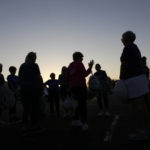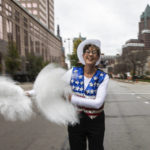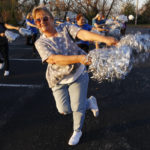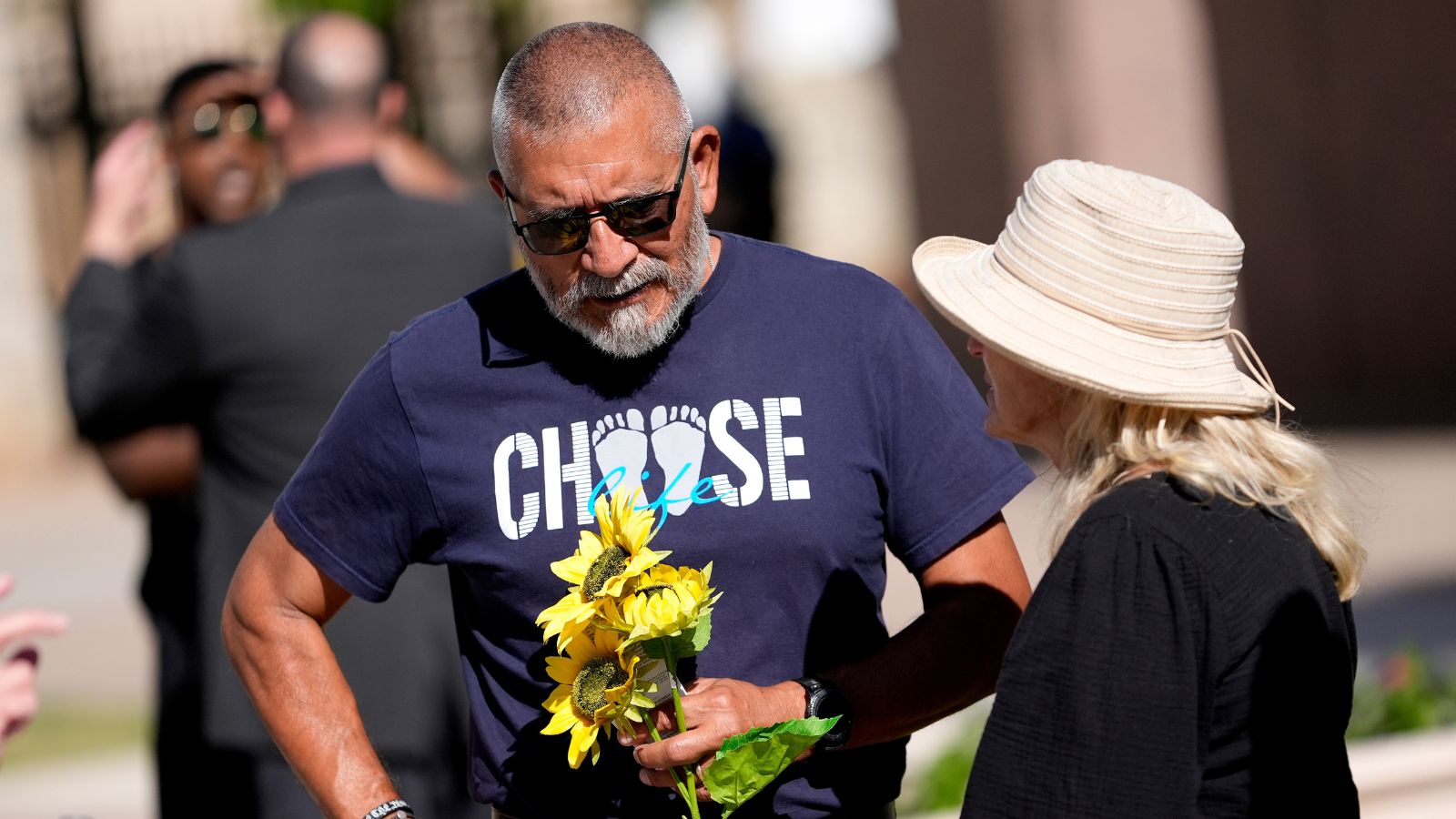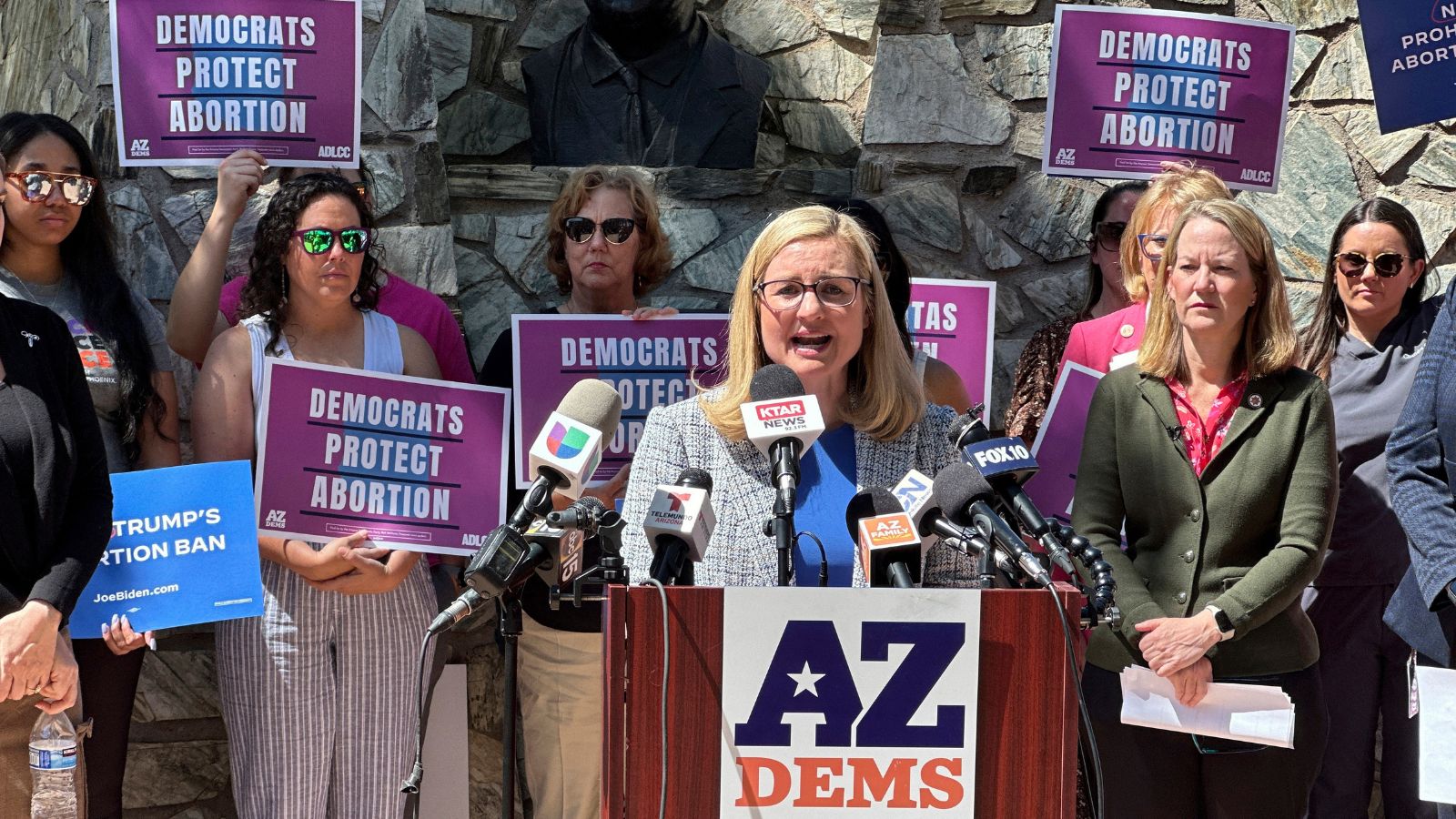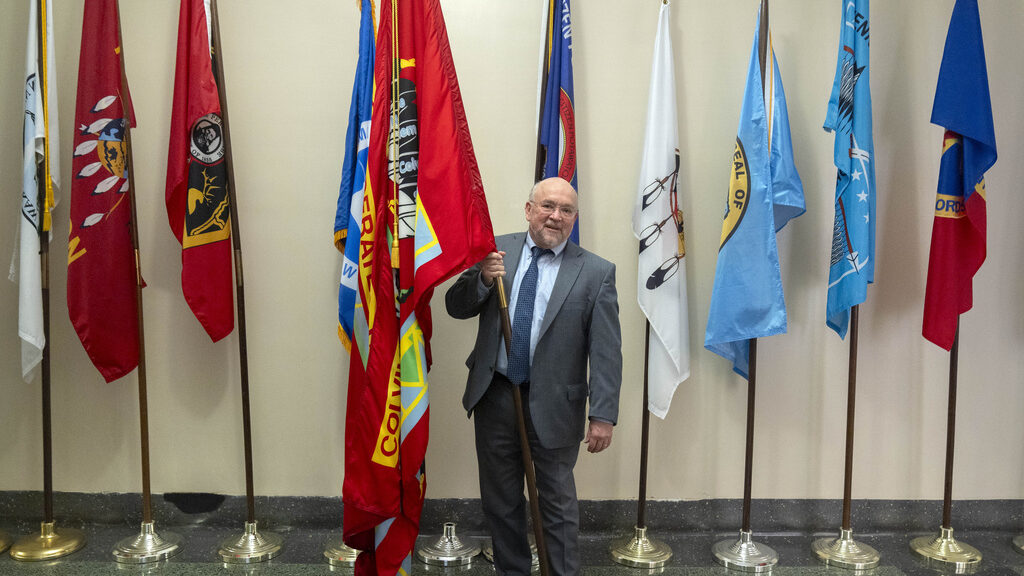To heal after parade tragedy, the Grannies must march again
Nov 17, 2022, 10:11 PM | Updated: Nov 18, 2022, 7:46 pm

Pam Junion, 65, and other members of the Milwaukee Dancing Grannies practice in a parking lot in Milwaukee on Wednesday, Nov. 2, 2022. Junion is one of a few women who answered a call for new members as the group attempted to rebuild in the face of tragedy. Three Dancing Grannies and one group member’s husband were among those killed at a Christmas parade in Waukesha, Wisconsin, when the driver of an SUV struck them on the parade route. Dozens more, including some Grannies, were injured. (AP Photo/Martha Irvine)
(AP Photo/Martha Irvine)
MILWAUKEE (AP) — The high winds forecasters warned about are blasting down Wisconsin Avenue, but 15 grandmothers lining up in the street are ready to march.
They’re dressed for this morning’s parade in wide-brimmed hats held on tight with elastic chin straps. And they’ve subbed out red pom poms for white ones so the dye won’t run in rain that is teasing its return from a leaden November sky.
“This is like my calling,” says Kathi Schmeling, a retired human resources assistant, her grin framed by the crimson lipstick that is a signature of the women who call themselves the Milwaukee Dancing Grannies. “This is my happy place.”
Given where she and the others have come from, it’s no small accomplishment that they’re here at all.
A year ago, a driver plowed an SUV through a Christmas parade in the nearby suburb of Waukesha, killing six people and scarring many more. Four of the victims were from the Dancing Grannies, including their longtime leaders, threatening to extinguish the tight-knit band of women — not old, they say, just well-seasoned — first drawn together by the aerobics craze of the 1980s.
Somehow, they held on. They drew on resilience banked well before the tragedy, during bouts with cancer and divorce, the loss of jobs and loves ones. They accepted that to keep going would require taking a risk on new ways of doing things, with new dancers who had not lived their history.
Soon, though, the calendar will come full circle. And to keep moving forward, the group has made a decision. When the parade returns to Main Street in Waukesha, they need to go back.
Today, when the speakers atop the group’s sound truck erupt in downtown Milwaukee, the Grannies sashay to a carefree beat: “We are family! I’ve got all my sisters with me!”
Pom poms and lipstick, though, distract from conflicted feelings about the parade a few weeks ahead.
“If we go past that spot, if we (stop to) remember it, if I lose it and start crying …” says Kathy Zdarstek, 77, whose line partner, dancing a few feet away, was killed that night last November.
Others are anxious to return.
“That fool thought he could take my Main Street away from me,” says Donna Kalik, 61, who was a spectator when the Grannies were mowed down right in front of her, then weeks later applied to join the ranks of the survivors. “He doesn’t know who he’s messing with.”
Regardless, every step today brings Waukesha that much closer.
____
On the phone last Nov. 21, Tamara Durand sounded ecstatic. “I got an earlier flight! I can be in the parade!”
Durand, a teacher and long-ago cheerleader, was the newest Granny. When she showed up in the blue velvet jacket, long skirt and white fur hat reserved for winter parades, though, leader Virginia Sorenson sounded mildly annoyed.
“What are you doing here?” asked Sorenson, 79, who’d already arranged the dancers in even rows.
In recent years, retirements had shrunk the group’s ranks to fewer than a dozen dancers. And only eight were slated to march through Waukesha’s cozy downtown, where the annual Christmas parade, cancelled the previous year because of the pandemic, had returned with a new theme: “Comfort and Joy.”
Having a round number of dancers pleased Sorenson, a career nurse who had given up performing since a hip replacement, but remained the leader, equal parts demanding and doting.
“Ginny was our glue — she held the group together,” one of the others dancing that day recently recalled.
With the sun dropping, Sorenson reshuffled the lineup. She would step in to help carry the banner, replacing a granddaughter unable to make it. Dancers arranged in alternating rows would follow the lead of 71-year-old Leanna Owen, the “little firecracker” who managed an apartment complex and was the group’s longtime coach.
In the middle, Betty Streng, a retired systems analyst for the city of Milwaukee dancing in her second parade, would serve as one of the anchors. Durand and two others would bring up the rear.
Families thronged Main when the Grannies funneled into the procession behind a Girl Scout troop and a youth dance corps. At 4:38 p.m. they sauntered through an intersection to a crowd favorite, Winter Wonderland, swinging pom poms skyward.
In the din, they didn’t hear the red SUV plowing down Main until it hit them.
“It was a flash,” says Donna Kalik, who was watching the parade with her boyfriend from a coffee shop window. “And as I’m running out there’s a body on the left of me and there’s a body on the right … It looked like a war zone.”
At a restaurant next door, Brian Peterson, an off-duty paramedic, glanced out the window just as bodies clad in vivid blue were flung through the air.
“When I got out the front door the first thing that will stick with me forever, besides people lying everywhere, is that it was absolutely dead silent,” Peterson says. “And then the crescendo of screams started.”
A few feet from the curb, Ginny Sorenson lay dead. Hurled to the sidewalk, the bodies of Owen and Durand, both killed instantly, would not be identified until hours later.
In the middle of the street, Streng, 64, lay unconscious and not breathing.
“Wake up, Betty! Wake up!” implored Schmeling, her fellow Granny.
Crouched on the pavement, Peterson cradled Streng’s head, pushing back on her jaw to force open the airway. One touch and he knew the dancer’s skull was shattered. When her eyes fluttered, he lay down to hold her head still until help could arrive. But there were so many victims and when rescuers finally came for Streng, Peterson rushed to aid others.
Nearby, Wilhelm Hospel, the husband of another Granny who was a regular volunteer, lay bruised and battered, and succumbed to his injuries the following day. Down Main, an 8-year-old who had been parading with his Little League team, and a 52-year-old woman marching with co-workers from a local bank were also killed.
Wandering through the chaos, Schmeling found fellow dancer Sharon Millard, a teacher’s aide so invested in the group that she had called to sign up the night before the birth of her first grandchild.
“Kathi!” she said, dazed. “What’s going to happen to the Grannies?”
___
The pain of the weeks after Waukesha was followed by doubt.
“There’s no leaders. There’s no history. There’s nothing left,” Jeannie Knutson, one of the Original Grannies, recalls thinking.
Two of the dancers were in the hospital, including Streng, comatose for five days afterward with a double skull fracture.
Others nursed hidden scars. Zdarstek kept replaying the choice she’d made to dance on the left side of the formation — leaving Durand a few feet to her right, in death’s path. At work, Millard broke down when “Winter Wonderland” played over the school intercom.
Knutson, who had skipped the parade to watch her Green Bay Packers, pictured the spot she would have taken. Listening to survivors during a meetup at the home of a former Granny 10 days afterward, she mulled the route forward. It seemed like they owed it to those who’d died to keep the group going, or at least to try.
The group chose two Grannies to be their new leaders: Knutson, because of her work in human resources, and Jan Kwiatkowski, a family therapist and ordained chaplain.
The day of Sorenson’s funeral, a group of 15 dancers, retirees and family members went from the chapel to a parade in nearby Franklin, walking silently, arm in arm, in memory of those lost.
“Milwaukee Dancing Grannies are gathering our thoughts, regrouping,” Knutson posted online. The only way to regroup would be to rebuild.
Dozens of notes flooded the inbox of a group that had never added more than a couple of dancers at a time. When they reconvened in late January, 34 hopefuls showed up, forming a dance line that circled the tables of a fraternal hall.
“I felt like we were the rock that they could lean on,” says Doreen Lopez, 66, a native New Yorker who came searching for a way to connect with others in a new hometown. “We all felt the grief and the sorrow for what had happened … but we weren’t emotionally involved, so we thought we could be the strong ones.
___
The only thing he could be certain of was that her name was Betty.
Ever since Waukesha, Peterson, the paramedic, had struggled to sleep. In 34 years of answering emergency calls he had never felt wired to a patient the way he did to the silver-haired dancer who’d been whisked away on a stretcher.
He did not know that, rushed into an operating room that night with blood pressing against her brain, Betty Streng had come within minutes of a permanent coma or death, according to the surgeon, Dr. Christopher Sarkiss.
Streng had pulled through with no memory of what happened. But after Peterson contacted the group, her family reached out to him and a few nights before Christmas, he and his wife rang the Strengs’ front bell.
The Betty at the door was missing half her hair, sutures crossed her shaven scalp, and she leaned hard on a walker. To Peterson, she looked “glorious,” a “miracle.”
A long winter of rehabilitation lay ahead. So, too, for the Grannies.
“Ginny always had this saying before parades: ‘If you make a mistake, if you get off kilter, if you drop your pom poms, no matter what, you keep on dancing,'” says Kwiatkowski, 67, one of the new leaders. “And that’s the mantra we all grabbed on to.”
Inside the fraternal hall, leaders split new arrivals into two groups, dancing in turns to fit everyone in tight quarters. Some peeled away in the following weeks, reluctant to commit to months of practices and more than 20 parades a year. A few veterans, taxed by memories, retired.
Others moved to take on the coaching roles left vacant by Sorenson and Owen. But when poms poms were passed out, some new arrivals noticed theirs were marked with the names of those killed. It didn’t feel right to use them.
When one of the new trainees, Donna Kalik, broke her leg a month in, the leaders told her not to worry about falling behind on routines. Eventually, she earned a spot as the volunteer coordinator.
Before Waukesha, many Grannies had followed what now seemed like an outdated ethic, keeping disagreements to themselves. To keep going, Kwiatkowski and Knutson decided, dancers needed to tell them about tensions surrounding the group’s reorganization so they could be resolved in meetings after practice.
“We’re like sisters,” Streng says. “You get along or you don’t get along. You agree or disagree. But you care about each other.”
Returning to the hospital to start physical therapy, it took Streng nearly a half minute to cover 10 feet with the walker, her balance shaky. She spent weeks learning to steady herself, practicing tasks like getting in and out of a bed and raising herself off the floor.
“There was a lot of anxiety, fear of falling, fear of not being able to progress, fear of the unknown,” therapist Lisa Miller says.
By late January, though, Streng started moving around the house without the walker. In February, she put it aside altogether. In March, the Grannies called.
Early on a frigid Saturday the group gathered in the lobby of a Milwaukee hotel, ready to dance in a parade for the first time since Waukesha. Ginny Sorenson would be so proud, her husband, Dave, told the dancers, before a toast.
When the Original Grannies joined the St. Patrick’s Day procession, new arrivals wearing sashes identifying them as trainees walked alongside.
Just behind, slow and steady, came Streng and another injured Granny, backed up by family members with wheelchairs. Streng, though, walked the whole route on her own. And she was beaming.
___
By spring’s end, the Grannies — increasingly seen as an embodiment of the region’s “Waukesha Strong” motto — were fielding parade invites from around the state. In town after town, spectators shouted their thanks for the group’s return, shaping hearts with outstretched hands.
“It’s bittersweet at times,” Knutson says. “I mean, before the tragedy you’d have crowds clapping and singing along, but now it’s totally different.”
The exhilaration was tempered. When sirens sounded to clear parades routes, some who’d been at Waukesha flinched and others teared up. At a Memorial Day parade, dancers glanced up to see police snipers on rooftops of surrounding buildings.
But as more trainees mastered the dance routines and were promoted to Granny status, there was much to celebrate.
The group’s regular banner carrier, 14-year-old Ali Wachter, a family friend of a retired dancer, returned to processions “because I didn’t want my fears to overcome me.” At a parade in Ginny Sorenson’s hometown of Muskego, her granddaughters were invited to lead the way.
On July 4, the group danced in a morning parade, then headed to Streng’s house for a cookout before another march scheduled for afternoon’s end. The celebration swelled when a fire engine carrying Peterson and his co-workers came by to join in.
Then phones began to buzz: a mass shooter in the Chicago suburb of Highland Park, barely an hour away, had turned another holiday parade into a bloodbath.
On television that night, seeing footage of the suburban street littered with lawn chairs and coolers abandoned by terrified spectators felt like a “gut punch,” Kwiatkowski says. Shaken, two of the dancers who’d survived Waukesha stopped coming to practice.
The rest danced on. To Allenton in August with five new members promoted to their ranks. To the Wisconsin Dells in September, with the names of those they’d lost printed inside hearts on costumes echoing the Packers’ green and gold.
Then October arrived and the memories of Waukesha were revived in a Milwaukee courtroom.
It had long been clear at least one of the Grannies would be called to testify at the trial of Darrell Brooks, 40, charged with murder and numerous other counts stemming from the violence at Waukesha, which came after he fled a heated dispute with his ex-girlfriend.
Prosecutors, calling witnesses from the length of the parade route and the pursuit that followed, did not divulge who would need to testify or how many. As testimony unfolded, the Grannies who lived through Waukesha were sequestered, barred from talking with one another about their recollections or the trial.
In the end only one now-retired dancer was called to testify. But some continued to keep their distance from the proceedings.
“I didn’t want to hear about it,” says Schmeling, recalling the anger that welled up inside when she recounted her memory of Waukesha for prosecutors before the trial. “I’m done with that chapter.”
For others, watching the trial stirred intense feelings. During a parade weekend in northern Wisconsin, a few gathered around a laptop to watch jurors inspect the vehicle used in the crime. Seeing one of the Grannies’ white fur hats hanging from a side-view mirror left some feeling shaky.
As the judge prepared to read the jury’s verdict, Kwiatkowski was waiting to get off a plane. When Brooks was convicted of all 76 counts against him, she felt such relief she had to stop herself from shouting out loud in the aircraft’s crowded aisle. The trial had been hard on some of the Grannies, but its completion put them over one more hurdle.
___
The storm blowing through Milwaukee this morning has kept away all but the hardiest spectators, leaving the Grannies to strut their stuff past block after block of nearly empty sidewalks.
But it takes little to visualize the crowds — and the memories — awaiting just a few weeks ahead.
“A year later and I can still break down talking about this … It’s like a demon I’m fighting,” says Peterson, who plans to walk alongside Betty Streng in the Waukesha parade, scheduled for Dec. 4, to the place where he found her on the pavement.
“I know where the spot is,” he says, “and I just hope I make it.”
For banner carrier Ali Wachter, fears about the parade increase as the day gets closer, though she knows the group has retired “Winter Wonderland.” But going back will also bring comfort, she hopes, proof that the recovery of the past year is permanent.
“We’ve got to get back out there,” says Knutson, one of the Original Grannies.
When the speakers atop her group’s sound truck short out a few blocks before the terminus of today’s prelude, Knutson and the others know what to do.
They keep count of the beat, even without music. A few mouth the words of the song gone missing, while others maintain carefully lipsticked smiles.
They move to the message Ginny Sorenson long preached. No matter what, you’ve got to keep on dancing.
Copyright © The Associated Press. All rights reserved. This material may not be published, broadcast, rewritten or redistributed.

